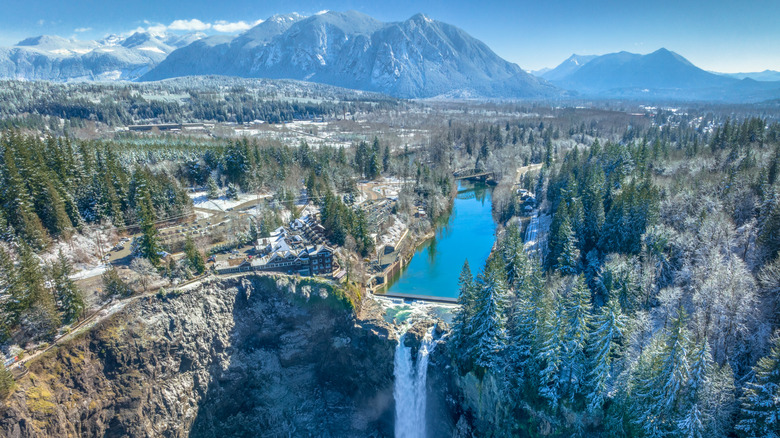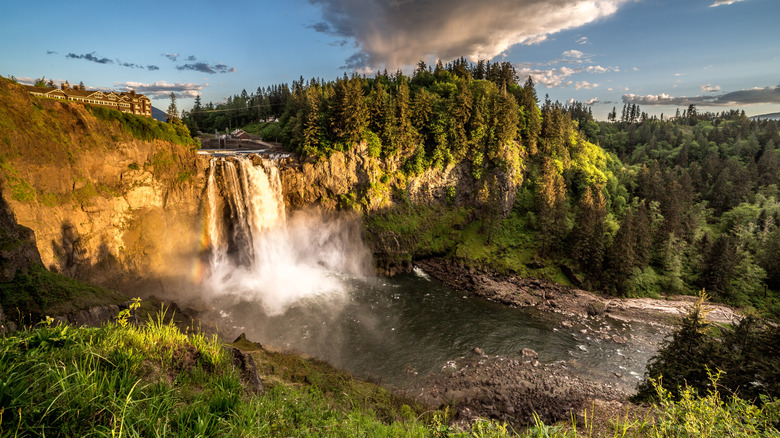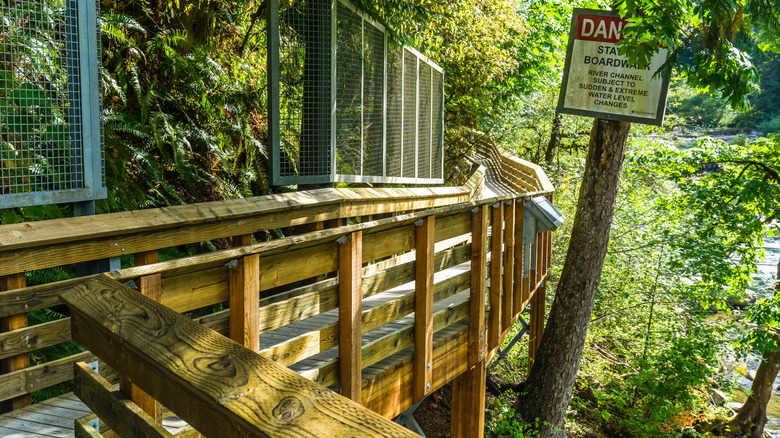Situated Between Seattle And Spokane Is A Magnificently Scenic Waterfall Taller Than Niagara
Surrounded by towering pines and the roar of waterfalls, it's hard to imagine that you're close to the most highly populated city in Washington State and only a short day trip away from its runner-up. Just forty minutes from the vibrant soul of Seattle, Pike Place Market, is a stunning double waterfall called Snoqualmie Falls, which cascades down a staggering 268 feet into the river below making it twice as high as New York's Niagra Falls. You may recognize these two streams of water joining into one from the opening of David Lynch's cult classic TV show "Twin Peaks," but you should know that the falls could look a little different if you go when there's been a lot of rain — and the Seattle area is known for its rain. The more precipitation there is, the more streams of water will be rushing over the cliffside, and it will be particularly thunderous, too.
After Mount Rainier, aka the Crown of the Pacific Northwest, this is the most popular natural destination in the state, and it has been so for people who live in the region for a very long time. When settlers first came to the area, they would hike up the sides, daring each other to lean out over the falls, but these waterfalls were a beloved place before they ever crossed the Mississippi. They were named after the moon by the Snoqualmie people, who made their homes in the valley and believed it to be the place where humankind was born, or the spot where the beaver climbed into the sky to bring forests and flame to the Earth.
How to hike to Snoqualmie Falls
If you've already worked your way through the best of the seemingly endless outdoor activities around Spokane, Washington, it's worth driving four hours on I-90 to explore Snoqualmie Falls. Those who want to hike up the Snoqualmie Falls Trail should plan to be walking for about 45 minutes. The route to the higher viewing platform is not too difficult, and it's a hiking trail that may be accessible for wheelchair users with all-terrain tires, since there are paved portions and wooden boardwalks. The way down to the lower viewpoint, however, is a very steep gravel path that some hikers may find tricky.
Walking between the pines and hemlocks found along the trail on a misty morning is a beautiful experience in and of itself. Though it's less than a mile between the two viewing platforms, the trail is engaging even if you've had your fill of looking at the waterfalls. As you walk, you can learn about the people, plants, and animals that have made this breathtaking place their home over the centuries thanks to informational signs along the path.
How to visit the falls
As much as these incredible falls might feel like undiscovered country, they are a popular destination, and you will literally pass a gift shop as you park your car in the lot at the trailhead. On weekend afternoons when the weather is nice, it can get fairly crowded, so you're better off coming on a weekday, first thing in the morning, or both if you're hoping to get some quiet time to yourself on the trail. There's enough parking for around 50 vehicles, but it's also accessible by public transit, so you could have even more competition for views on some days.
Obviously, you don't want to be squinting at the outline of the falls through driving rain or hiking the trails while being buffeted by the wind, but if conditions are safe, consider visiting Snoqualmie Falls in dreary, rainy weather. The more water there is, the more powerful the flow of water becomes, so if you visit on a rainy day after the snow melts in early spring, you'll be greeted by the deafening roar of the falls at full power.


